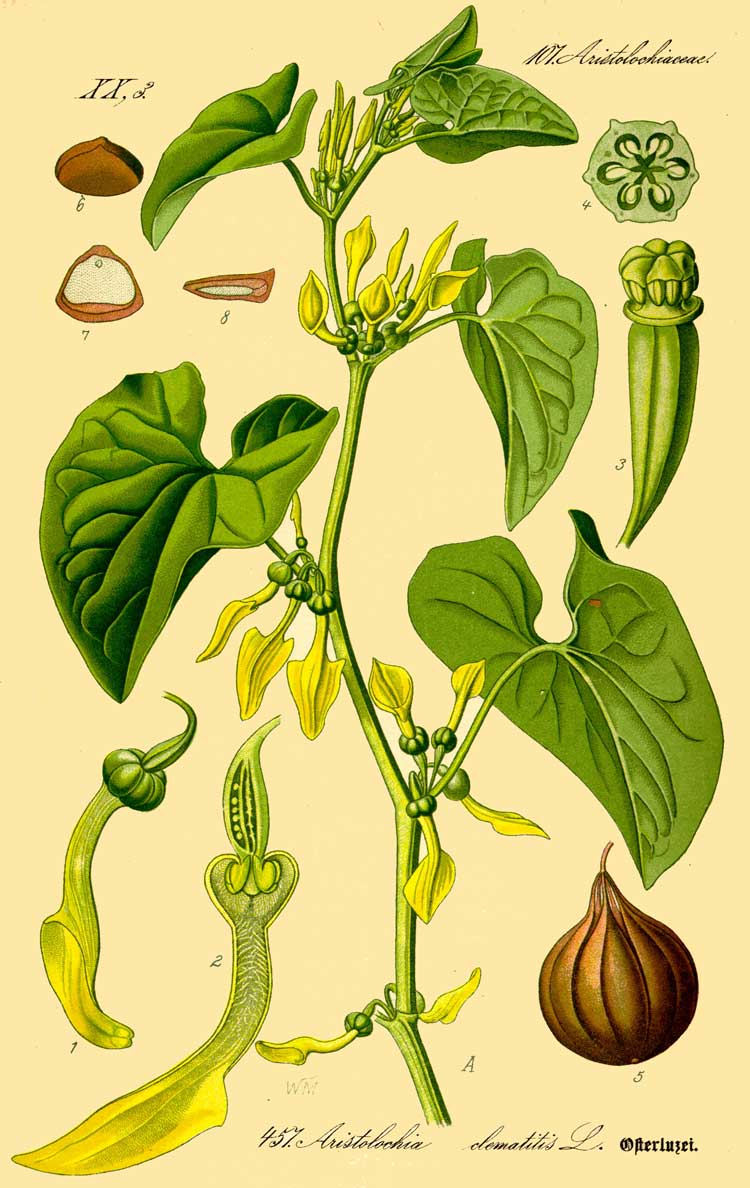
Aristolochia clematitis (*)
Classification System: APG IV
Superregnum: Eukaryota
Regnum: Plantae
Cladus: Angiosperms
Cladus: Magnoliids
Ordo: Piperales
Familia: Aristolochiaceae
Subfamilia: Aristolochioideae
Genus: Aristolochia
Species: Aristolochia clematitis
Name
Aristolochia clematitis L., Sp. Pl. 962. 1753.
Synonyms
Aristolochia infesta Salisb., Prodr. stirp. Chap. Allerton, 215. 1796, nom. illeg.
Aristolochia longa Georgi, Beschr. russ. Reich vol. 3, 5, 1274. 1800, nom. illeg. (non L.).
Aristolochia rotunda Georgi, Beschr. russ. Reich vol. 3, 5, 1274. 1800, nom. illeg. (non L.).
Aristolochia tenuis Houtt.
Distribution
Native distribution areas:
Continental: Europe
Albania, Austria, Belgium, ?Baleares, England, Bulgaria, Corsica, Czech Republic, Slovakia, France, Germany, Greece, Switzerland, Netherlands, Spain, Hungary, Italy, Slovenia, Croatia, Macedonia, Serbia & Kosovo, Montenegro, Bosnia & Hercegovina, Poland, Romania, C-, W- & E-European Russia, Ukraine, Belarus, Crimea
Continental: Asie
Northern Caucasus, Azerbaijan, Kazakhstan, Turkey (E-Anatolia, Inner Anatolia, N-Anatolia, NE-Anatolia, NW-Anatolia: Bithynia, WN-Anatolia)
References: Brummitt, R.K. 2001. TDWG – World Geographical Scheme for Recording Plant Distributions, 2nd Edition
References
Linnaeus, C. 1753. Species Plantarum. Tomus II: 962. Reference page.
USDA, NRCS. 2006. The PLANTS Database, 6 March 2006 (http://plants.usda.gov). Data compiled from various sources by Mark W. Skinner. National Plant Data Center, Baton Rouge, LA 70874-4490 USA.
Links
Hassler, M. 2018. Aristolochia clematitis. World Plants: Synonymic Checklists of the Vascular Plants of the World In: Roskovh, Y., Abucay, L., Orrell, T., Nicolson, D., Bailly, N., Kirk, P., Bourgoin, T., DeWalt, R.E., Decock, W., De Wever, A., Nieukerken, E. van, Zarucchi, J. & Penev, L., eds. 2018. Species 2000 & ITIS Catalogue of Life. Published on the internet. Accessed: 2018 Dec. 27. Reference page.
International Plant Names Index. 2018. Aristolochia clematitis. Published online. Accessed: Dec. 27 2018.
The Plant List 2013. Aristolochia clematitis in The Plant List Version 1.1. Published on the internet. Accessed: 2018 Dec. 27.
Tropicos.org 2018. Aristolochia clematitis. Missouri Botanical Garden. Published on the internet. Accessed: 2018 Dec. 27.
{{GRIN|sp|4086
Vernacular names
العربية: زراوند ظياني
azərbaycanca: Ağəsməyəbənzər zəravənd, Adi zəravənd
български: обикновена вълча ябълка
català: Aristolòquia sarmentosa, Llengua viperina
čeština: podražec křovištní
Cymraeg: Esgorlys
dansk: Hjertebladet Slangerod
Deutsch: Gewöhnliche Osterluzei, Osterluzei
English: birthwort, European birthwort
Esperanto: Kutima aristolokio
español: clematitide, aristoloquia, aristoloquia común, aristoloquia sarmentosa, aristoloquia vulgar, aristolòquia sarmentosa, clematítide, cornamusa enredada
suomi: Herttapiippuruoho, piippuruoho
français: Aristoloche clématite, Aristoloche clematite
Gaelg: Cleaysh vuc
hornjoserbsce: Pryšćencowy kokornak
magyar: Közönséges farkasalma
日本語: ウマノスズクサ属
қазақша: Жиренше
македонски: Волчје јаболко
Nederlands: Pijpbloem
polski: Kokornak powojnikowy, Kokornak powojowaty, Kokornak powojnikowaty
português: aristolóquia
română: Mărul lupului
русский: Кирказон ломоносовидный, Кирказон обыкновенный
slovenčina: vlkovec obyčajný
српски / srpski: Вучја јабука
svenska: Hålrot
українська: Хвилівник звичайний
中文: 铁线莲状马兜铃
Aristolochia clematitis, the (European) birthwort, is a twining herbaceous plant in the family Aristolochiaceae, which is native to Europe. The leaves are heart shaped and the flowers are pale yellow and tubular in form. The plant seeks light by ascending the stems of surrounding plants.
Toxicity
It was formerly used as a medicinal plant, though it is poisonous, and is now occasionally found established outside of its native range as a relic of cultivation. It is now thought to be the cause of thousands of kidney failures in Romania, Bulgaria, Serbia, Bosnia and Herzegovina and Croatia where the plant is thought to be unintentionally consumed through contaminated flour, yet contradicted by ongoing research.[1][2] Urinary tract malignancies among those who have consumed the plant are also reported.[3] The link between kidney failure and aristolochic acid, which the plant contains, was discovered after a clinic for obesity in Belgium used herbal products based on another plant of the same genus as a diuretic. After a few months, some of the patients experienced kidney failure.[4]
See also
Balkan nephropathy
References
Grollman, A. P.; Shibutani, S.; Moriya, M.; Miller, F.; Wu, L.; Moll, U.; Suzuki, N.; Fernandes, A.; Rosenquist, T.; Medverec, Z.; Jakovina, K.; Brdar, B.; Slade, N.; Turesky, R. J.; Goodenough, A. K.; Rieger, R.; Vukelic, M.; Jelakovic, B. (2007). "Aristolochic acid and the etiology of endemic (Balkan) nephropathy". Proceedings of the National Academy of Sciences. 104 (29): 12129–34. Bibcode:2007PNAS..10412129G. doi:10.1073/pnas.0701248104. PMC 1913550. PMID 17620607.
Batuman, Elif. "Poisoned Land." The New Yorker. August 12 & 19, 2013: 42-47. Print.
Broe, M. E. D. (2012). "Chinese herbs nephropathy and Balkan endemic nephropathy: Toward a single entity, aristolochic acid nephropathy". Kidney International. 81 (6): 513–515. doi:10.1038/ki.2011.428. PMID 22373701.
Vanherweghem, J. L.; Tielemans, C.; Abramowicz, D.; Depierreux, M.; Vanhaelen-Fastre, R.; Vanhaelen, M.; Dratwa, M.; Richard, C.; Vandervelde, D.; Verbeelen, D.; Jadoul, M. (1993). "Rapidly progressive interstitial renal fibrosis in young women: Association with slimming regimen including Chinese herbs". The Lancet. 341 (8842): 387–91. doi:10.1016/0140-6736(93)92984-2. PMID 8094166. S2CID 32428737.
Retrieved from "http://en.wikipedia.org/"
All text is available under the terms of the GNU Free Documentation License

